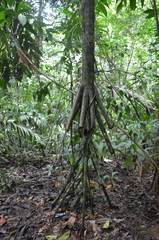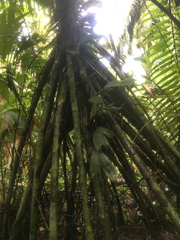
Neotropical Flora
|
Family: Arecaceae
[Iriartea exorrhiza Mart., moreSocratea albolineata Steyerm., Socratea durissima H.Wendl.] |
Stilt palm, Jira Monoecious, slender, stilt-rooted tree, 25-30 m tall; wood very hard; trunk to 15 cm diam, ringed; stilt roots 1-3 m high, often replacing the trunk at base, bearing short spines; crownshaft bluish-green, very long and bulging at base. Blades 2 m long or more; petioles rounded on underside; leaflets +/- regular, in 8-14 pairs, narrow at base, greatly broadened to deeply toothed at apex (the terminal pair united, truncate), inserted on rachis at an angle (the proximal edge higher on rachis, the distal edge lower on rachis), often splitting in age, the various parts then directed at different angles, the ribs numerous, raised on lower surface; juvenile plants much like adults, the blades entire or with few pinnae. Inflorescences borne below the crownshaft; spathes 2, thin, 40-50 cm long, both deciduous as a single unit; spadix stout with up to 16 stout branches, to 60 cm long; peduncles about as long as or longer than rachis, stout, flattened laterally, drooping in fruit; staminate flowers to 1.2 cm long and 1.5 cm wide, soon falling; sepals 3, minute; petals 3, thick, concave; stamens numerous (ca 50), about as long as petals, the filaments very short; pistillate flower usually borne between 2 staminate flowers, much smaller and obscured by them. Fruits oblong, 2.5-3 cm long, with a small subapical point, the cupule bowl-shaped, to 1 cm wide; seeds 1-3, to 2.5 cm long, beaked at base and marked with anastomosing lines, enveloped very loosely by thin woody husk at maturity. Croat 8160, 8638. Common throughout the forest; sometimes locally abundant. Seasonal behavior uncertain. Flowering chiefly in the early rainy season (May to August), but sometimes in the dry season as well. Most fruits mature in the middle to late dry season. Juvenile or mature-sized fruits may be found on the ground at most times of the year. Oppenheimer (pers. comm.) reports that fruits are eaten by white-faced monkeys during March and April. |
|
|
|
Powered by Symbiota.





























































